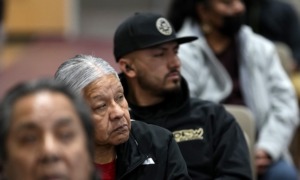On Saturday, Jan. 30, Washington, D.C., got its second snowstorm in six weeks. Not nearly as big as the first (only 4 to 5 inches) – but big enough that school openings were delayed the next Monday.
And big enough that not one but three young black men knocked on my door asking if they could shovel the walks. I took a moment to ask each if he was working. Each was looking for work. One was a recent high school graduate; one a dropout with a GED and a spotty work history; one a college student hoping to earn enough money to stay in school. As with the first storm, I paid for help that I didn’t really need in order to support a young person.
But these young men need more than pocket money .While Washington, D.C.-area residents were hunkering down to weather what would be two blizzards in a week, the area’s young black men are struggling to get clear of a seemingly perpetual storm that limits their visibility, cripples their mobility and increases their risk of preventable “accidents” associated with success-threatening if not life-threatening behaviors that stem from idleness and futility.
According to the U.S. Bureau of Labor Statistics, more than half of black male 16- to 19-year-olds are unemployed, twice the national average. This number counts only those who are actively looking for work. Only one in seven young black men actually has a job (the joblessness rate is climbing the fastest for this population.)
Washington, D.C., has the worst teen employment rate in the country, according to BLS. At least once a month, I hear or read a story on Washington’s chronic youth unemployment problem. The titles do a good job of explaining the crisis: National Public Radio (Jan. 10) “Black Teenage Males Crushed by Unemployment” and The Washington Post (Nov. 24, 2009) “Blacks Hit hard by Economy’s Punch: 34.5 percent of young African American men are unemployed.” The stories themselves explain why I have used the phrase “perpetual storm” rather than “crisis.” This is not a thunderstorm, it’s a never-ending monsoon.
• Andre Johnson, 18, at the YouthBuild Charter School, explained that he applies for jobs every day, but now he applies online, not to save time, but to hide his race. Allison Lee, job placement specialist at YouthBuild, confirms his suspicions, having confirmed job openings in advance and then having students told that there were no jobs available (NPR story).
• Delonta Spriggs, 24, spends time holed up in his mother’s apartment, trying to stay off the streets and out of trouble. He lost his job last year, had trouble finding steady work, completed a construction apprenticeship program but has yet to land a job that lasted longer than a week. He’s trying hard to stay away from the drug dealing he did before to support his daughter.
These young people are in the storm. They are being pummeled by the elements. They’re working hard to find temporary shelter from the weather – applying online, escaping into soap operas, but in the blinding headwinds, they can see no sign that they are getting closer to their destination – a full-time job with promise.
Have African-American males brought this on themselves? Is Spriggs’ conclusion that black youth have been “labeled for not wanting to do nothing” making it difficult for those who do want to succeed to get a fair chance true? Probably.
Especially in these tough times when competition for jobs is steep, employers have little incentive to take chances. And the white-black differences in employment rates cannot be explained away by either poverty or the achievement gap. The “attainment gap” is linked to race. Low-income white teens (household income under $20,000) are more likely to find work than upper-income black teens (household income between $100,000 and $150,000). Black college graduates have unemployment rates twice as high as whites.
President Barack Obama is moving a major jobs bill. But will this bill move young black men into jobs? Not likely, unless the president acknowledges the problem and proposes specific solutions, something he has yet to do. (He made no mention of the historic youth unemployment numbers in his State of the Union Address).
Green jobs are great. But the jobs that young African-American men get – when they get them, entry-level jobs in construction, retail and the service industries, are not bouncing back quickly. The employer-sponsored training programs and apprenticeships are drying up, and the discretionary programs that fill the gaps have already been slated for cuts.
I know youth programs will try to provide shelter from the storm, even as their budgets are cut. But it may be time to step into the storm ourselves on this one. The $1.5 billion Youth Jobs Act of 2010, introduced in December as a part of the Workforce Investment Act, is the largest of a handful of proposals focused on providing summer and full-time jobs, job training and G.E.D. and post-secondary access to disadvantaged youth. Track their progress; educate your youth, staff and boards; write your Congress members.
Karen Pittman is executive director of the Forum for Youth Investment. An expanded version of this column and links to related readings are available at http://www.forumforyouthinvestment.org.































